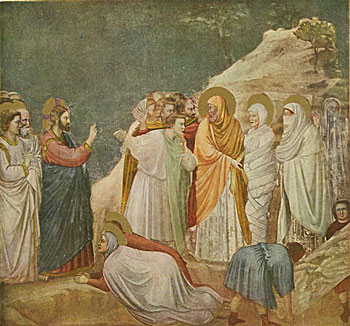
John
W. Dixon, Jr., Art
as a Means of Thinking and of Grace

The proper response to Giotto's image is not curiosity
and interest, or even sympathy, but empathy. Sympathy is a feeling,
necessary to the religious life. Empathy is more nearly a physical
response. If I see a porter with a heavy load on his back, I might
feel sympathetic, sorry for his pain. If my back hurts, that is empathy,
a kind of identification.
The proper response to Giotto’s painting is empathy.
His gestures and postural movements are so grave, so weighty and forceful
that our bodies can, if we will, feel the weight and force in ourselves.
Since Giotto has made these gestures and postures so much a part of
the event that he enables us to participate in the event and not just
see it from the outside as illustration. The Gospel story is not just
then but now. As the worshippers (not the spectators or the critics
or the historians) proceed around the room from one painting to the
next, responding as they are instructed by the paintings to respond,
their bodies empathetically absorb the movements and thereby the action
of the narrative. By participating in that action, they participate
in the meaning of the event, thereby training souls to the Christian
interpretation of the world.



